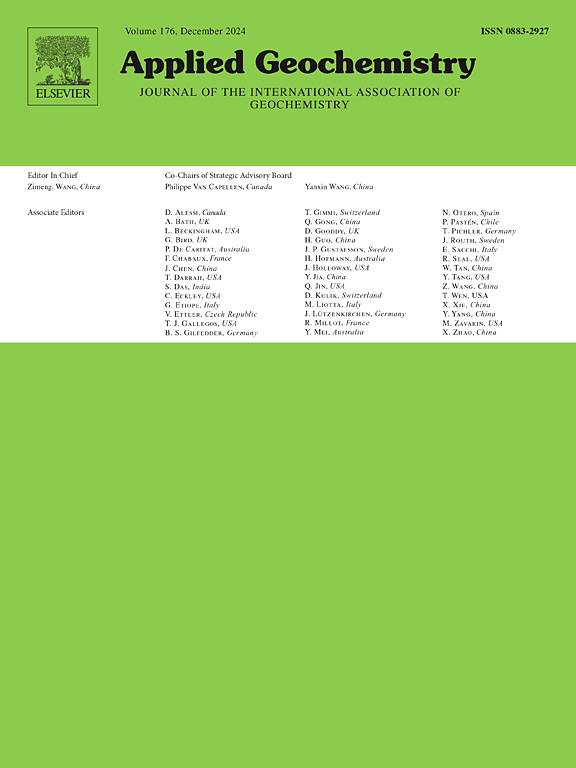Diavik废石项目:从一个解构的实验废石堆中进行放置后硫化物风化的研究
IF 3.1
3区 地球科学
Q1 GEOCHEMISTRY & GEOPHYSICS
引用次数: 0
摘要
对一个15米高的低硫化物(0.035 wt% S)实验废石堆进行了解构,以获得密集的、空间定位的样品集,用于表征固相矿物学、微生物群落组成和孔隙水地球化学。位于加拿大北部的实验试桩在建造8年后被拆除。低pH的孔隙水通常与SO4和溶解金属浓度升高有关。试验桩内存在不同pH值区域,表明硫化物和碳酸盐矿物分布不均匀。最可能数分析表明,中性硫氧化细菌在解构时是与酸性矿井排水相关的最一致的繁殖种群。通过将桩施工时收集的未风化样品与解构阶段收集的风化样品进行比较,研究了矿物学演化。这一分析表明,废石中C含量被耗尽,但废石中总S含量保持相对不变。利用C和总S计算的中和电位比值表明,膏体pH值低的区域(低至4.0)通常与被归类为潜在产酸或不确定产酸电位的物质的存在一致。解构研究表明,试桩内部存在可变条件(如在几米范围内pH值急剧变化),表明废石非均质性影响了试桩内孔隙水的地球化学演化。本文章由计算机程序翻译,如有差异,请以英文原文为准。
Diavik Waste Rock Project: Post-emplacement investigation of sulfide weathering from a deconstructed experimental waste-rock pile
Deconstruction of a 15 m high low-sulfide (0.035 wt% S) experimental waste-rock pile was conducted to obtain a dense, spatially located sample set for characterization of the solid-phase mineralogy, microbiological community composition, and pore-water geochemistry. The experimental test pile, located in northern Canada, was deconstructed 8 years after construction. Pore-water with low pH was generally associated with elevated concentrations of SO4 and dissolved metals. Regions of differing pH were present within the test pile, indicating heterogeneous distribution of sulfide and carbonate minerals. Most probable number analysis showed that neutrophilic sulfur oxidizing bacteria were the most consistently prolific of populations associated with acid mine drainage at the time of deconstruction. The mineralogical evolution was examined through comparison of unweathered samples collected at the time of pile construction to weathered samples collected during the deconstruction phase. This analysis indicated that the C content of the waste rock was depleted, but the total S content of the waste rock remained relatively unchanged. Neutralization potential ratios calculated using C and total S indicate that regions of low paste pH (as low as 4.0) were generally consistent with the presence of material classified as potentially acid generating or of uncertain acid generating potential. The deconstruction study shows that variable conditions exist within the test pile (e.g., sharp changes in pH over a few meters) suggesting that waste-rock heterogeneity has influenced the geochemical evolution of the pore water within the test pile.
求助全文
通过发布文献求助,成功后即可免费获取论文全文。
去求助
来源期刊

Applied Geochemistry
地学-地球化学与地球物理
CiteScore
6.10
自引率
8.80%
发文量
272
审稿时长
65 days
期刊介绍:
Applied Geochemistry is an international journal devoted to publication of original research papers, rapid research communications and selected review papers in geochemistry and urban geochemistry which have some practical application to an aspect of human endeavour, such as the preservation of the environment, health, waste disposal and the search for resources. Papers on applications of inorganic, organic and isotope geochemistry and geochemical processes are therefore welcome provided they meet the main criterion. Spatial and temporal monitoring case studies are only of interest to our international readership if they present new ideas of broad application.
Topics covered include: (1) Environmental geochemistry (including natural and anthropogenic aspects, and protection and remediation strategies); (2) Hydrogeochemistry (surface and groundwater); (3) Medical (urban) geochemistry; (4) The search for energy resources (in particular unconventional oil and gas or emerging metal resources); (5) Energy exploitation (in particular geothermal energy and CCS); (6) Upgrading of energy and mineral resources where there is a direct geochemical application; and (7) Waste disposal, including nuclear waste disposal.
 求助内容:
求助内容: 应助结果提醒方式:
应助结果提醒方式:


